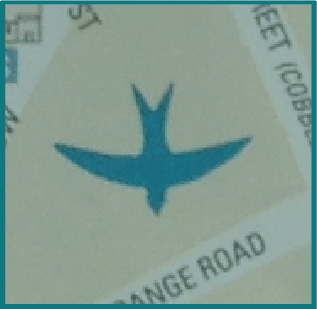 You get to know a place differently when someone dies. Then the geography of hospices, funeral parlours, benches, stones, plaques, cemeteries, churches, chapels, temples, registry offices, solicitors’ signs and charity shops, gleams in a new and tender line of sight. One undertaker, whose display urns were half obscured by venetian blinds near Prison Corner, pitched itself as the only family-owned and independent funeral service in Lewes. But they took so long to clean my grandfather’s headstone that my parents, thinking ahead, looked elsewhere for someone to manage their own arrangements. On the corner of St Nicholas’ Lane and Friars Walk, there briefly bloomed a more Lewesian shopfront of ‘green’ wicker coffins run by three women with spiky hair. The shop was gone by the time we needed it, replaced by a minimalist business selling fine loose tea and doll-size French custard cakes.
You get to know a place differently when someone dies. Then the geography of hospices, funeral parlours, benches, stones, plaques, cemeteries, churches, chapels, temples, registry offices, solicitors’ signs and charity shops, gleams in a new and tender line of sight. One undertaker, whose display urns were half obscured by venetian blinds near Prison Corner, pitched itself as the only family-owned and independent funeral service in Lewes. But they took so long to clean my grandfather’s headstone that my parents, thinking ahead, looked elsewhere for someone to manage their own arrangements. On the corner of St Nicholas’ Lane and Friars Walk, there briefly bloomed a more Lewesian shopfront of ‘green’ wicker coffins run by three women with spiky hair. The shop was gone by the time we needed it, replaced by a minimalist business selling fine loose tea and doll-size French custard cakes.
Olivia Laing’s psychogeography of the town celebrates its long, unquiet relationship with death, most powerfully in the butchery of the Battle of Lewes in 1264. Body parts fed the Downs above the Nevill Estate and mixed with the chalk beneath De Montfort Road. Bonfire Night, brutally festive, remembers 17 Protestant martyrs burned at the stake in the 1550s on the site of the Town Hall. The memorial nearby lists 378 Lewes men ‘fallen’ in war. Laing recounts that railway workers constructing the Brighton to Hastings line in 1845 discovered a well stuffed with stinking bodies believed to be Royalist soldiers from the 13th century. They shovelled them into the new train embankments. The Ouse river plain which opens out beyond them is never innocent of the association with Virginia Woolf’s suicide.
Laing relocates Woolf’s ribbon-avenue of memory from behind to beneath: ‘the ground we walk on is nothing more than a pit of bones, from which the grass unstinting grows’. My scientist mother would have reversed this: ‘The grass grows unstintingly, out of the pit.’ She loved Lewes and especially its inglorious history, saying it took an American to fully enjoy the fun. For one of her last birthdays, we paid for a step on the climb to the Norman Keep, supporting a fundraising effort by the Sussex Archaeological Society. Engravings were capped at 25 characters, so we took a line from the Greek poet, Cavafy: Keep Ithaca always in mind. Cavafy tells us that, like Odysseus struggling to find Ithaca, the destination is made by the adventures en route. My mother came from Ithaca, upstate New York. Laing stopped at our step on her meanderings. But she is doubtful. ‘What if Ithaca is no more than an island of sirens, a place where time stops: a static heaven at the journey’s end?’ she writes. She has given up faith in a destination, ‘except to be certain that bones do not always stay buried and that I will undoubtedly be outlived by the plastic bags with which my generation has bedecked the globe, as the Romans’ tweezers outlasted their mortal bodies. Forget Ithaca.’
The psychogeographical drift subverts all odysseys, for sure. Laing’s best hope is that the destination will vanish like a rainbow at the point of arrival. But this is only because the past runs persistently into the present. Invited to participate in a mappening of purposeless punting around a town, I inevitably drifted to my mother, even at the carpark behind Harvey’s Depot, where I found a door filled tight with Sussex brick. As I walk on, I notice that the undertaker has upscaled from Prison Corner to a chrome-and-white showroom on the High Street, its outsize lily display oddly like the ladies’ dresses that used to grace that window front. I know that all deaths are different; that cars crash regularly on Kingston Corner. Lewes Cemetery, which the council says is ‘maintained to a high standard with floral displays and shrub borders’, is getting full. The Railway Land Trust warns us the town needs to plan for persistent flooding in which houses should be on stilts, and who knows how the bones will be kept down then? Death maps a place, but so does love. My mother will always be present, walking with me through the Priory Ruins in her outsize sneakers and loud pink shirt, getting lost on the way. After the cancer had returned, she wrote stories about a girl who was gifted in being able to see people from Lewes’ past. Retrace your steps. That’s all I need to do.
With thanks to Olivia Laing, Nick Fairclough and the Lewes Psychogeography Group.
Reference:
Laing, Olivia. To the River: A Journey beneath the Surface. Edinburgh: Canongate, 2011.
